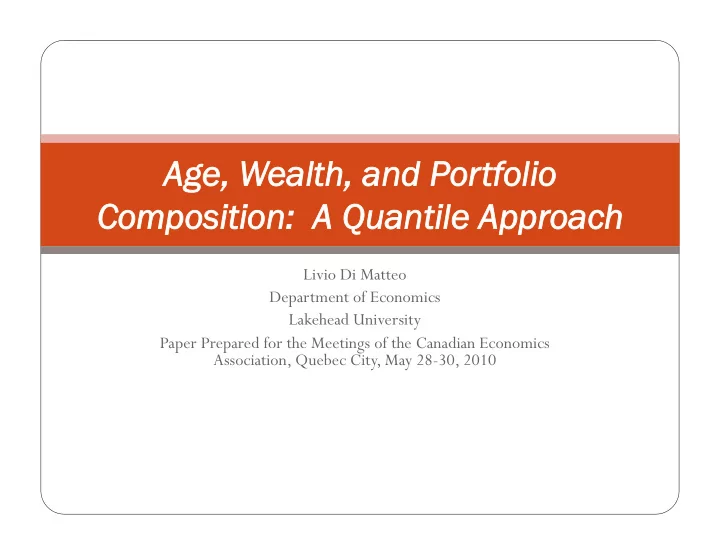

Age, W e, Wea ealth, a , and P Portfolio Composition: A : A Quant Quantile ile Ap Approach Livio Di Matteo Department of Economics Lakehead University Paper Prepared for the Meetings of the Canadian Economics Association, Quebec City, May 28-30, 2010
Questions Quantile regression used to examine wealth determinants & wealth-age profile Bequest or life-cycle saving? A life-cycle transition? Is variable impact affected by wealth level?
OUTLINE Bequest vs life-cycle saving The Data LOWESS quantiles Quantile Regressions Results & Conclusion
Saving Motivation Life cycle saving Bequest saving Precautionary saving Bequest saving – voluntary vs accidental Dynan, Skinner, Zeldes (2002) Fan (2006) Conley & Galenson (1994, 1998)
The Data 7,156 census linked probated decedents for Ontario 1892, 1902 16 wealth categories including real estate and financial assets
Table 1: Aggregate Statistics
Figure 1
Figure 2
Figure 3
Quantile Regressions Quantile: A value below which a given part of the data must fall. Eg. 0.2 quantile means 20 percent of observations below this value. Estimation: STATA 10, OLS, Simultaneous quantile regression Model LnW i = a o + a 1 A +a 2 A 2 + a 3 Z 1 + ….a n Z n + E i
Table 3: Quantile Wealth Regressions
Wealth-Age Profiles (Source: Table 3)
Table 4: Real Estate & Financial Assets
Financial & Real Estate – Age Profiles (Source: Table 4) 8 10 6 8 4 6 2 q30 q30 q50 4 q50 q90 0 q90 0 20 40 60 80 100 120 2 -2 -4 0 0 20 40 60 80 100 120 -6 -2
Summary Statistically significant wealth-age profiles but low rate of decline – more consistent with bequest motive or life-cycle with substantial uncertainty. Life-cycle transition process still early. Tendency to “hump-shaped profile” greater at lower wealth levels Religious affiliation & birthplace matter more at higher wealth levels
Recommend
More recommend